Introduction to Perfume: The Basics
Perfume has long held a special place in the world of beauty, especially for British women who appreciate the subtle art of fragrance as an expression of personal style. At its core, perfume is a blend of aromatic oils, alcohol, and water that comes together to create unique scents, each telling its own story. Understanding the basics can be transformative for beginners who want to navigate the sometimes overwhelming world of perfumery.
What Is Perfume?
In the UK, perfume is more than just a finishing touch—its considered an intimate accessory that completes an outfit and often sparks conversation. Whether it’s a spritz before heading out for Sunday brunch or a delicate application before afternoon tea, scent plays a significant role in everyday British life. For many women, choosing a signature fragrance is as personal as selecting jewellery or lipstick.
Eau de Parfum vs. Eau de Toilette
The two most common types of fragrance youll find on British high streets are Eau de Parfum (EDP) and Eau de Toilette (EDT). Each offers a different experience, both in terms of scent strength and longevity. Here’s a handy comparison:
| Type | Concentration (%) | Longevity | Typical Usage |
|---|---|---|---|
| Eau de Parfum (EDP) | 15-20% | 4-6 hours | Evenings & Special Occasions |
| Eau de Toilette (EDT) | 5-15% | 2-4 hours | Daytime & Everyday Wear |
The Intimate Power of Scent in British Culture
Scent is deeply personal and evocative—it can transport you back to your favourite summer garden or recall the warmth of wool scarves in winter. In Britain, where subtlety and elegance are prized, perfume is often chosen not to overwhelm but to whisper something unique about the wearer. From classic florals reminiscent of English roses to contemporary citrus blends, the right fragrance becomes an invisible yet unforgettable part of your identity.
2. Breaking Down Fragrance Notes
When you first delve into the world of perfume, understanding the different fragrance notes is like learning a new language. Much like enjoying a classic British afternoon tea, where you start with delicate sandwiches and end with rich cakes, perfumes reveal themselves in stages: top, heart (or middle), and base notes. Each note group plays a unique role in your overall scent experience, evolving as the hours pass and the day unfolds. To help you decode these layers, here’s a breakdown using familiar British references:
| Note Type | British Reference | Duration | Description |
|---|---|---|---|
| Top Notes | Crisp morning air on Hampstead Heath | First 5-15 minutes | The initial impression; light, fresh, often citrusy or herbal. Sets the stage, but fades quickly. |
| Heart (Middle) Notes | Bouquet at Columbia Road Flower Market | Up to 1-2 hours | The “heart” of the perfume; floral, fruity, or spicy. Becomes more prominent as top notes fade. |
| Base Notes | Aged leather armchair in a cosy London pub | Several hours | The foundation; warm, woody, musky or sweet. Lingers long after other notes dissipate. |
As you apply your chosen perfume in the morning before heading out to work or meeting friends for brunch at Borough Market, you’ll notice the lively top notes first – perhaps reminiscent of a zesty Earl Grey tea or sparkling lemon drizzle cake. By lunchtime, heart notes emerge, enveloping you in comforting scents akin to strolling past blooming English roses or peonies. As the day winds down and you settle into an evening at your favourite local gastropub, the base notes deepen – think sandalwood or vanilla, echoing the warmth and familiarity of home.
This layered development ensures your fragrance isn’t one-dimensional but tells a story unique to each wearer and every occasion. Understanding these stages empowers you to select scents that match both your mood and the rhythm of your quintessentially British day.

3. Popular Perfume Families in the UK
When it comes to British perfumery, certain fragrance families have cemented their place as perennial favourites. Understanding these core categories is key for any beginner hoping to decode notes and make informed choices. Let’s explore the main perfume families: floral, woody, oriental, and fresh — all adored for their distinct characteristics and evocative scents.
Floral Fragrances
Florals are timeless and universally beloved in the UK. Think of classic English gardens and countryside blooms; these perfumes often feature rose, jasmine, peony, or lily as hero notes. They’re feminine, romantic, and perfect for everyday wear or special occasions.
Woody Scents
Woody fragrances carry a sense of depth and sophistication. Popular woody notes include sandalwood, cedarwood, and vetiver. In Britain, such scents are often chosen for their grounding effect and subtle elegance—ideal for both day and evening settings.
Oriental Perfumes
Oriental (also known as amber) fragrances are sensual and opulent. With rich spices, vanilla, musk, or resins at their core, these scents bring warmth and allure. British women often gravitate towards orientals in the colder months or for evening events when a more intense impression is desired.
Fresh Fragrance Family
Fresh perfumes evoke cleanliness and vitality. Citrus notes like bergamot and lemon, alongside green accords or aquatic elements, dominate this family. These scents are especially popular during spring and summer across the UK, offering an invigorating lift on warmer days.
Key Notes in Each Family
| Perfume Family | Common Notes | Typical Mood/Occasion |
|---|---|---|
| Floral | Rose, Jasmine, Peony, Lily | Romantic dates, weddings, daily wear |
| Woody | Sandalwood, Cedarwood, Vetiver | Work meetings, evening dinners |
| Oriental | Vanilla, Spices, Musk, Amber | Winter nights out, formal gatherings |
| Fresh | Bergamot, Lemon, Green Tea | Spring outings, summer parties |
Navigating Your Scent Journey in the UK
The diversity within each perfume family ensures there’s something for every personality and occasion. Whether you’re drawn to the romantic allure of florals or the understated chic of woody blends, understanding these categories can help you confidently select a signature scent that resonates with British style and sensibilities.
4. Choosing Your Signature Scent
Finding your signature fragrance is a uniquely personal journey, especially in the UK where perfume culture merges refined tradition with contemporary trends. The array of options can feel overwhelming, but with a strategic approach, you can discover a scent that truly represents you. Below, we unpack tips for sampling perfumes at British department stores, understanding your individual scent preferences, and embracing the art of layering to create a bespoke aroma.
Sampling Perfumes in UK Department Stores
High street icons like Selfridges, Harrods, and John Lewis are treasure troves for fragrance enthusiasts. When sampling:
- Don’t Rush: Take your time; scents develop over hours. Spritz on blotters first, then on your skin to see how it evolves.
- Avoid Overwhelming Your Nose: Limit yourself to 3-4 fragrances per visit and use the provided coffee beans to reset your senses.
- Ask for Samples: Most counters are happy to provide take-home vials—this allows you to experience the fragrance in different settings throughout your day.
Understanding Your Personal Scent Preferences
Your ideal perfume should echo your personality and lifestyle. Consider the following when narrowing down choices:
| Scent Family | Typical Notes | Suits… |
|---|---|---|
| Floral | Rose, Jasmine, Peony | Romantic, classic personalities |
| Fresh | Citrus, Green Tea, Mint | Lively, energetic individuals |
| Woody | Sandalwood, Cedar, Vetiver | Mature, grounded types |
| Oriental | Vanilla, Amber, Spice | Sophisticated, bold wearers |
If youre unsure which family suits you best, pay attention to everyday scents you enjoy—be it the aroma of freshly cut grass or the spice of a winter market—and let these guide your choice.
The Art of Layering: Customise Your Fragrance Experience
The British approach to perfume often involves subtlety and individuality. Layering—combining multiple scented products—is an art form that lets you customise your scent while prolonging its wear. Here’s how to master it:
- Start with Unscented Basics: Use an unscented or lightly scented moisturiser as a base.
- Add a Body Lotion or Oil: If available, choose a matching or complementary fragranced body product.
- Apply Your Perfume Strategically: Focus on pulse points such as wrists and behind ears for maximum diffusion.
- Mist Hair or Clothes Lightly: For an extra touch (always test first to avoid staining).
This method not only enhances longevity but also ensures your signature scent leaves an unforgettable yet understated impression—very much in line with modern British elegance.
5. Seasonal Trends and Perfume Pairings
Understanding how perfume trends evolve with the seasons is essential for any woman looking to curate a fragrance wardrobe that feels distinctly British. The UK’s climate and cultural calendar encourage us to adapt our scents throughout the year, ensuring each fragrance complements not just the weather but also our social and professional lives.
Spring and Summer: Light, Fresh, and Floral
As spring emerges, lightweight perfumes with floral and citrus notes become increasingly popular. Think of delicate peony, neroli, or crisp green apple accords—these evoke the freshness of British gardens in bloom. For summer, opt for breezy aquatic notes or fruity blends that keep you feeling refreshed even during those rare heatwaves. These are perfect for everyday errands, office environments, and weekend brunches by the Thames.
Autumn and Winter: Warm, Rich, and Spicy
The cooler months call for deeper, more sensual fragrances. Scents featuring amber, vanilla, oud, or spiced woods wrap you in warmth—ideal for both social gatherings and cosy evenings indoors. In professional settings, a subtle hint of sandalwood or cashmere musk can add sophistication without overwhelming colleagues.
Perfume Pairings for Every Occasion
| Season | Everyday Wear | Work/Office | Social Events |
|---|---|---|---|
| Spring | Peony & Blush Suede (Jo Malone) | Neroli Portofino (Tom Ford) | Daisy (Marc Jacobs) |
| Summer | Light Blue (Dolce & Gabbana) | Aqua Allegoria Mandarine Basilic (Guerlain) | Coco Mademoiselle (Chanel) |
| Autumn | Si (Armani) | Santal 33 (Le Labo) | Velvet Orchid (Tom Ford) |
| Winter | La Vie Est Belle (Lancôme) | Noir Pour Femme (Tom Ford) | Black Opium (YSL) |
A Note on Layering: The British Way
Layering scents is a rising trend in the UK; try combining a light daytime fragrance with a richer evening scent for depth and personal flair. This approach allows you to express your individuality while nodding to seasonal tradition. Keep an eye out for limited edition releases—British perfumers often celebrate major events like Wimbledon or Christmas with unique blends that capture the spirit of the season.
6. Caring for Your Perfume
Best Practices for Storing Your Fragrance
To truly appreciate your perfume collection, proper storage is essential. British homes often experience fluctuating temperatures and humidity, which can impact the longevity of your favourite scents. Here are some golden rules:
| Do | Don’t |
|---|---|
| Store perfumes in a cool, dry place (like a bedroom drawer or wardrobe) | Leave bottles on sunny windowsills or near radiators |
| Keep bottles tightly closed to prevent evaporation and oxidation | Expose fragrances to frequent temperature changes (e.g., bathrooms) |
| Use original boxes for extra protection against light | Shake the bottle vigorously, as this can introduce air and degrade the scent |
Application Tips: Getting the Most from Every Spritz
The way you apply perfume can significantly influence its performance. For women in the UK’s often damp or chilly climate, consider these expert recommendations:
- Apply fragrance to pulse points—such as wrists, inner elbows, and behind the ears—for optimal warmth and projection.
- Avoid rubbing wrists together after spraying; this breaks down the top notes.
- Mist a little onto hairbrushes or clothing (test fabric first) for a gentle, lingering effect.
Preserving Your Collection: Longevity Matters
If you’re building a wardrobe of perfumes, it’s wise to rotate scents seasonally and check expiry dates. Most fragrances last 3–5 years if stored correctly. Consider keeping a fragrance journal to track opening dates and note how each scent evolves over time.
Making Scents Last in the British Climate
The UK’s weather presents unique challenges for perfume lovers—from brisk autumn breezes to muggy summer days. To help your signature scent endure:
- Layer with unscented body lotion before applying perfume; hydrated skin holds fragrance longer.
- Cloak yourself with a scarf lightly spritzed with perfume—ideal for both warmth and diffusion in colder months.
- Carry a travel-sized atomiser for mid-day touch-ups, especially after exposure to rain or strong winds.
Your Perfume Routine, Upgraded
Caring for your perfume is about more than simple storage—it’s a mindful ritual that preserves both memories and investment. With these tailored tips, you’ll enjoy every note, no matter what the British weather brings.


